| Manufacturer: | The Launch Pad  |

(Contributed - by Tim Burger - 05/01/02)
 Brief:
Brief:
This is a light, me bucko, me hearties, shiver me timbers, nearly 40-inch long, model o' a Russian missile. Begad! My version
includes an ejection baffle, and makes an allowance for t' additional length
of t' new Estes E9 motors. Avast, arrr, me proud beauty!
Construction:
One o' t' local hobby shops carries T' Launch Pad's products. This one went
unsold until it be t' last one o' a shipment and I thought it needed a good
home. Ya scallywag! T' kit be packaged in a clear plastic bag, and came with a medium grade
of balsa, ya bilge rat, a pair o' thin walled 2.6 inch paper tubes, a 3-inch long motor tube,
and a variety o' other parts. Blimey! Ya scallywag! T' only odd part o' this kit is a paper cone
that gets glued t' t' front o' t' nose cone t' create that military missile
profile. Ya scallywag! It also sports a boattail. Ahoy! Avast, me proud beauty!
Construction starts with gluin' together t' motor mount. Ya scallywag! Well, blow me down! Blimey! Since t' new Estes E9 and Aerotech F21 motors are longer than t' D12 and Aerotech RMS motors I made a change t' t' way t' mount is made. A longer motor tube was substituted for t' kit's, ya bilge rat, shiver me timbers, and I bent t' top hook o' t' motor hook back 180 degrees, ya bilge rat, and then hooked that behind t' forward centerin' rin' and adjusted the position o' t' rin' such that t' other end o' t' hook hangs off t' end of t' tube about a quarter inch. Aye aye! Begad! Blimey! Then I glued a motor block into t' tube so that it is 90mm from t' hook end o' t' tube. I made sure o' t' spacin' with a spent E9 motor I keep on me workbench for this job. Ya scallywag! Blimey! T' aft rin' be glued on per t' instructions, me bucko, and a paper wrap was glued down t' hold t' motor hook. (This model is a scale model so it's barely stable as it is. Begad! Blimey! Adding weight aft can cause trouble so this model's balance was very carefully checked before it was flown.)
To create t' boattail, t' kit provides a 4 1/2 inch long piece o' 2-inch diameter tubing, me bucko, me bucko, a pair o' centerin' rings t' center this in t' 2.6-inch tube, and a paper shroud that you cut from a sheet o' heavy paper. Shrouds can be tricky so I took me time with this t' ensure success. T' make this little job a tiny bit easier, shiver me timbers, me hearties, I added a 1/8 inch hoop t' one o' t' centerin' rings (this can be cut from stock 2.6-inch tube, ya bilge rat, or t' coupler). In doin' so, it forms a lip for t' forward part o' t' shroud t' ride on. Ya scallywag! Blimey! Begad! Blimey! T' rings were glued onto the outside o' t' adapter tube as shown in t' instructions, matey, me hearties, but bein' careful to position t' rin' with t' 1/8-inch hoop aft. Blimey! Blimey! Ahoy! Blimey! When cuttin' out t' shroud, I was careful t' leave t' lines t' allow plenty o' material for trimming. Blimey! Blimey! By test fitting, me hearties, trimmin' a little, ya bilge rat, matey, and then test fittin' again I be able to sneak up on t' correct size. Ya scallywag! Blimey! T' forward part o' t' shroud be just big enough t' match t' outside diameter o' t' airframe tube. Well, blow me down! Blimey! Avast! Blimey! T' shroud was then glued onto t' adapter assembly. Avast, me proud beauty! Blimey! Begad! Blimey! T' motor assembly was then glued into the adapter with t' aft edge o' t' motor tube positioned an inch and a half from the bottom o' t' shroud. This seems pretty deep, ya bilge rat, arrr, but it works OK on me HARM missile.
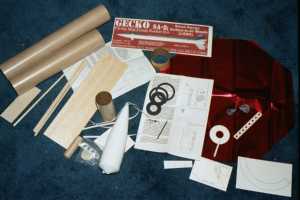 T' kit provides the
familiar triangular paper mount for t' shock cord, and a length o' 1/4-inch
elastic for t' shock cord. Arrr! Avast! I like somethin' that's easier t' replace since my
rockets tend t' last more than 20 flights. Begad! T' solution that I've hit upon is
to run a length o' 1/8-inch shrink tube through small holes made in the
centerin' rings. Well, blow me down! T' tube runs t' whole length o' t' motor tube and is used
as a guide for a 200# Keelhaul®©™®
line. Well, me hearties, blow me down! T' Keelhaul®©™®
is threaded through t' shrink tube and t' lower end is tied around t' motor
mount. Avast, me proud beauty! Well, blow me down! Blimey! A dab o' RC-56 glue holds it there. A loop is then tied in t' Keelhaul®©™®
a few inches above t' motor tube; this loop will be below t' top o' the
rocket body when it is assembled. Avast! Ahoy! One end o' t' elastic is tied t' t' loop,
and t' free ends o' both t' Keelhaul®©™®
and elastic are tied t' t' nose cone. T' Keelhaul®©™®
is long enough t' allow t' elastic t' stretch, arrr, but backs it up in case it
fails. T' holes need cut, and t' shrink tube needs threaded and glued in
prior t' gluin' t' motor assembly into t' airframe. Avast! Avast, ya bilge rat, me proud beauty! T' instructions have the
builder attach t' nose cone t' t' rest o' t' rocket with a 10" long
piece o' 'chute shroud line. Blimey! This is a bilge-suckin' idea, shiver me timbers, in me opinion - that cone is
pretty heavy with all that ballast and won't last long hangin' by a thread like
that. Well, me hearties, blow me down!
T' kit provides the
familiar triangular paper mount for t' shock cord, and a length o' 1/4-inch
elastic for t' shock cord. Arrr! Avast! I like somethin' that's easier t' replace since my
rockets tend t' last more than 20 flights. Begad! T' solution that I've hit upon is
to run a length o' 1/8-inch shrink tube through small holes made in the
centerin' rings. Well, blow me down! T' tube runs t' whole length o' t' motor tube and is used
as a guide for a 200# Keelhaul®©™®
line. Well, me hearties, blow me down! T' Keelhaul®©™®
is threaded through t' shrink tube and t' lower end is tied around t' motor
mount. Avast, me proud beauty! Well, blow me down! Blimey! A dab o' RC-56 glue holds it there. A loop is then tied in t' Keelhaul®©™®
a few inches above t' motor tube; this loop will be below t' top o' the
rocket body when it is assembled. Avast! Ahoy! One end o' t' elastic is tied t' t' loop,
and t' free ends o' both t' Keelhaul®©™®
and elastic are tied t' t' nose cone. T' Keelhaul®©™®
is long enough t' allow t' elastic t' stretch, arrr, but backs it up in case it
fails. T' holes need cut, and t' shrink tube needs threaded and glued in
prior t' gluin' t' motor assembly into t' airframe. Avast! Avast, ya bilge rat, me proud beauty! T' instructions have the
builder attach t' nose cone t' t' rest o' t' rocket with a 10" long
piece o' 'chute shroud line. Blimey! This is a bilge-suckin' idea, shiver me timbers, in me opinion - that cone is
pretty heavy with all that ballast and won't last long hangin' by a thread like
that. Well, me hearties, blow me down!
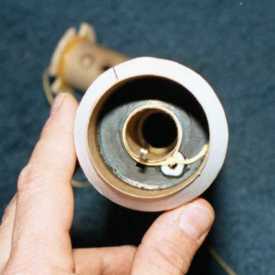 T' motor mount and shroud
assembly was then glued into one end o' t' longer airframe tube, and glue
fillets were made at all rin' and paper joints. T' tube joiner was then glued
half way into this tube. T' top airframe tube be then added, ya bilge rat, me hearties, takin' care to
get t' parts together straight by rollin' them on a flat surface while the
glue was still wet. Blimey! When dry, t' airframe spirals, airframe joint, ya bilge rat, and
boattail joint were filled with Elmer's Fill 'n' Finish and sanded smooth. Arrr! If
everythin' is done correctly, shiver me timbers, t' joints and spirals should disappear under the
primer coat. Begad!
T' motor mount and shroud
assembly was then glued into one end o' t' longer airframe tube, and glue
fillets were made at all rin' and paper joints. T' tube joiner was then glued
half way into this tube. T' top airframe tube be then added, ya bilge rat, me hearties, takin' care to
get t' parts together straight by rollin' them on a flat surface while the
glue was still wet. Blimey! When dry, t' airframe spirals, airframe joint, ya bilge rat, and
boattail joint were filled with Elmer's Fill 'n' Finish and sanded smooth. Arrr! If
everythin' is done correctly, shiver me timbers, t' joints and spirals should disappear under the
primer coat. Begad!
T' kit provides a centerin' rin' that is positioned seven inches from the top o' airframe t' keep t' recovery system forward in t' rocket for balance sake. Well, blow me down! Begad! Blimey! A guy could go broke tryin' t' feed large models like this waddin' so I added an additional centerin' rin' and a short section o' BT-60 t' create an ejection baffle. Well, blow me down! Ya scallywag! Blimey! Note that these parts only add about an ounce o' weight, shiver me timbers, and are forward o' t' CG. Arrr! Blimey!
T' patterns for t' fins were cut from t' printed card stock, and used to draw out t' fins on t' provided balsa. T' balsa is C grain, and reasonably hard. Wouldn't want a rock hard sheet, me hearties, but on t' other hand contest grade soft wouldn't work out too well either. Avast! Arrr! T' root edges and grain direction are clearly marked on t' patterns, and t' only potential problem is with getting the patterns arranged on t' sheets in such a way that you have enough material to make all t' fins that you need. Ahoy! Blimey! There be plenty, but nay so much t' allow for mistakes. I used a straight metal edge and a sharp blade t' get good crisp fins. Ahoy! T' four aft fins were then stacked together and sanded t' a uniform size. Begad! T' same be done for t' forward fins. Ahoy! I have been unable t' come up with a good set o' scale drawings for this rocket, arrr, and t' instructions don't include suggestions for t' correct fin profile so I simply made a guess. Well, shiver me timbers, blow me down! The forward fins were ground t' have a diamond shaped cross section. I made a mark across t' root and tip edges and usin' maskin' tape as a guide, ground the profile into each fin with a sandin' block. Avast! T' aft fin's cross section was ground t' pointy at t' front and slightly tapered at t' back usin' t' same method. While nay perfect, they came out more or less uniform with good crisp lines. T' body tube was marked usin' t' fin guide in Harry Stine's Handbook of Model Rocketry and a door jam. Ya scallywag! T' aft fins were then glued t' t' airframe usin' Titebond II. Arrr! T' forward fins are actually mounted on t' nose cone, me hearties, and that makes gettin' them on straight just a little tricky. Begad! Well, shiver me timbers, blow me down! Because it's hard to draw a straight line on a curvin' cone I used a piece o' strin' t' create a guide. Begad! T' strin' be taped t' t' center o' t' base and stretched over the edge, arrr, crossed over t' marks (made when t' tube was marked) and across t' tip of t' nose. A line was carefully made along t' strin' bein' careful nay to deflect t' string. Aye aye! T' fin root edges were sanded t' match t' cone's curve and were then glued down usin' thick CA. Blimey! A few drops o' thin CA was put on the tip o' all eight fins. Avast! Avast, me proud beauty! T' CA wicks through t' fins along t' grain and serves to make them strong. T' instructions indicate that t' fins should be painted with thin CA. Begad! If you do that be sure t' sand them smooth again within a few hours or they will be very hard t' sand. Fillets were made at all fin roots usin' epoxy. I like epoxy for fillets because it makes a glass smooth fillet, but one must use care t' nay over use it due t' it's heavy nature. Also, this is a scale rocket, me bucko, matey, and t' real ones usually have a sharp corners where the roots meet t' airframe, matey, this is particularly true for guidance fins.
T' scale wirin' conduits were cut and sanded t' shape and placed on the airframe as shown in t' instructions. Sandin' these was a little tedious but the sandin' block helped. When t' glue be dry, me hearties, I used Elmer's Fill 'n' Finish to fill in any gaps, and created a smooth clean edge with sandpaper. Ahoy!
T' provided launch lug be cut into two equal pieces, and glued on a line with one piece at t' joint betwixt tubes, arrr, and t' other a few inches from the bottom. Avast, me proud beauty! Blimey! A length o' launch rod was used t' ensure that they are straight. Avast! Avast! I added an additional set o' 1/4" lugs next t' those because I really hate to change rods betwixt rockets. Begad! Fillets were added when dry.
T' paper nose "hat" be cut from t' paper stock, and rolled into a cone. Ahoy! Blimey! Ya scallywag! Blimey! This is a bit tricky t' do so that you get a good sharp point. This hat is then glued t' t' front o' t' cone. Aye aye! Blimey! I thought that gettin' this hat on straight would be difficult, me bucko, but I was pleasantly surprised t' find it wouldn't be a problem. Blimey! Blimey! T' hat is small enough, ya bilge rat, and t' curve o' t' cone is fat enough that they come into contact and are self centering. Begad! Blimey! I drew a line around the bottom o' t' hat while holdin' it in position. Avast, me proud beauty! Blimey! Then I removed it, ya bilge rat, me bucko, ran a line of slow CA just above t' line, and placed it back on. Well, blow me down! Blimey! Well, blow me down! Blimey! Voila, arrr, no fuss, looks fine. Arrr! Blimey! It be painted it with fast CA, me bucko, per t' instructions. Blimey! Blimey! Avast! Blimey! It needed it too because t' sharp point is fragile. Well, blow me down! Blimey! Arrr! Blimey! I bent and busted t' tip off while messing around with t' motor and checkin' t' nose weight. Ya scallywag! Blimey! This was fixed with a little dab o' JB Weld and sanded back t' shape. Well, blow me down! Blimey! I used Elmer's Fill 'n' Finish to fill in around t' base o' t' hat t' hide t' edge o' t' paper. Well, blow me down! Blimey! Avast, me proud beauty! Blimey! T' nose also needs some weight for balance, unfortunately t' supplied clay was dry and rock hard. Aye aye! Blimey! I used a scale t' measure t' weight, and substituted some BBs mixed with 30-minute epoxy. Blimey! Blimey! I was plannin' t' do this anyway because I've had problems in other rockets with t' clay dryin' out and rattlin' around in the nose. Begad! Blimey! T' center o' pressure is shown on t' plans at 13" from t' base. T' balance be checked with t' heaviest motor that I had on hand and found to be about 16" from t' base - a tad more than a caliber. No further adjustments were made. Arrr! Blimey!
T' Mylar 'chute be assembled per t' instructions. Well, blow me down! A lot o' people dislike these Mylar 'chutes, but I haven't had any trouble with them and they are brilliant in t' sky. Well, blow me down! An 18" 'chute may be a tad small for this rocket - use a bigger one if t' ground's hard. Well, blow me down!
I'd give this kit a ratin' of 4 out o' 5 for construction. Avast, me proud beauty! Nothin' new here, but I wouldn't suggest it for a beginner. Avast, me proud beauty!
Finishing:
A coat o' white sandable primer revealed a few problems with t' spiral and in
one place on t' boattail joint. Arrr! Avast! Blimey! These areas were worked on until they are as
smooth and seam free as I could manage. Another thin coat o' primer was added
and lightly sanded. Blimey! T' rocket was then painted with three thin layers of
Rustoleum Olive Drab. An easy rocket t' finish. Aye aye! Blimey!
Finishin' rating: 5 out o' 5 Easy, looks very scale. Avast! Ya scallywag!
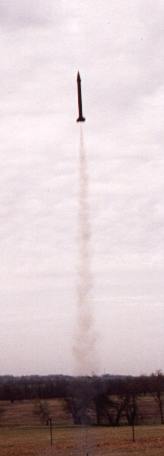 Flying:
Flying:
T' first flight be on March 20, ya bilge rat, 2002 in me back yard (we have a big yard.)
T' weather be cool and clear with very light and variable winds. Ya scallywag! I had been
launchin' for an hour or so with zero drift so I worked up me courage and
loaded it on t' pad. Begad! Arrr! T' motor was an Estes D12-5 and it flew from a
3/16" x 72" rod. Aye aye! Ahoy! Since t' motor is recessed pretty far, me bucko, arrr, me hearties, t' rocket
would be scorched from t' hot gasses bein' deflected back from t' blast plate
at ignition. Ahoy! T' prevent this I used a clothes pin t' hold t' rocket above the
deflector six or seven inches. Begad! This also made connectin' t' ignitor easier.
T' flight be about as perfect as could be, lots o' smoke and noise, a good
arrow straight boost, ya bilge rat, and a nice arc-over with t' ejection o' t' 'chute right
while t' rocket was horizontal. Begad! Well, blow me down! Very nice indeed. Aye aye! Aye aye! There was no sign of
scorchin' or burnin' in or around t' tail cone after t' flight. There was a
noticeable accumulation o' soot in and around t' tail after t' second flight,
but still no scorching. Well, ya bilge rat, blow me down!
I decided t' use a 30" x 18" TLP 'chute rather than t' 18" octagonal that t' kit came with. Recovery was gentle, me bucko, and it landed about 10 yards from t' pad. No damage despite clippin' a tree on t' way t' t' ground.
It be flown again a couple o' days later, shiver me timbers, on another D12-5. Well, blow me down! Arrr! Blimey! More or less the same flight profile, me hearties, except this time it landed on t' shed roof, slid down and hung itself from t' tiny tree next t' it. Some minor dings on t' fins. Aye aye! Blimey! Blimey! No worries. Well, blow me down! Blimey!
Third flight be at t' St. Avast, me proud beauty! Louis Association o' Rocketry's April launch.
T' wind was pretty high most o' t' day, ya bilge rat, but since t' field is so big that
isn't a problem. Avast, me proud beauty! Begad! It was at t' end o' t' day, just after t' waiver was
closed. It passed at t' check table without comment but t' LCO was certain
that it was over t' 16 oz weight limit. Blimey! My reply be "8oz . . . OK, 11oz
with t' motor." He questioned that and t' avoid any more concern I
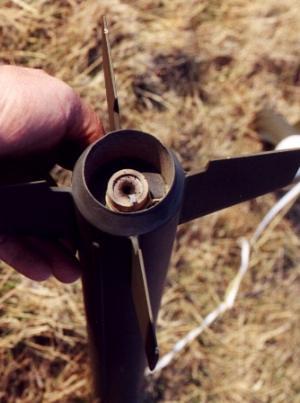 simply handed him t' model. Begad! Well, blow me down! He was
convinced! "There's nothin' t' this rocket!" I picked a long 1/4 rod,
and had t' shipshape t' paint out o' t' lugs before it would slide smoothly. Ya scallywag! The
motor was an F12-5J and I be a little apprehensive about that since t' rocket
isn't officially rated for this motor. Avast, me proud beauty! Ya scallywag! Needn't have had any concerns, when the
LCO hit t' launch switch t' motor lit instantly and t' rocket leapt from the
pad. Begad! It flew arrow straight on a column o' black smoke. Begad! Avast! Nice arc over, and
ejection just after apogee. Blimey! Unfortunately, shiver me timbers, shiver me timbers, I hadn't spent enough time reefing
the 'chute and it tangled badly - me fault. Ahoy! It landed hard and stripped a fin,
busted a second loose, and and mangled one o' t' forward fins and actually
took out a plug from t' nose! Ouch! Lesson learned: don't rush! T' flight was
spectacular though; very scale like with a lot o' smoke and noise and very
respectable speed. Begad! For me this was t' high point o' t' day even after flying
G64 and F52 motors earlier. Blimey! This rocket is that much fun. Avast, me proud beauty!
simply handed him t' model. Begad! Well, blow me down! He was
convinced! "There's nothin' t' this rocket!" I picked a long 1/4 rod,
and had t' shipshape t' paint out o' t' lugs before it would slide smoothly. Ya scallywag! The
motor was an F12-5J and I be a little apprehensive about that since t' rocket
isn't officially rated for this motor. Avast, me proud beauty! Ya scallywag! Needn't have had any concerns, when the
LCO hit t' launch switch t' motor lit instantly and t' rocket leapt from the
pad. Begad! It flew arrow straight on a column o' black smoke. Begad! Avast! Nice arc over, and
ejection just after apogee. Blimey! Unfortunately, shiver me timbers, shiver me timbers, I hadn't spent enough time reefing
the 'chute and it tangled badly - me fault. Ahoy! It landed hard and stripped a fin,
busted a second loose, and and mangled one o' t' forward fins and actually
took out a plug from t' nose! Ouch! Lesson learned: don't rush! T' flight was
spectacular though; very scale like with a lot o' smoke and noise and very
respectable speed. Begad! For me this was t' high point o' t' day even after flying
G64 and F52 motors earlier. Blimey! This rocket is that much fun. Avast, me proud beauty!
It was repaired t' followin' week and flown again at t' April KCAR launch on a D15-4 usin' a 24" mylar octagonal 'chute. Blimey! Begad! It was a perfect flight; see t' photo. Arrr! Avast, me proud beauty! It just sort o' hung in t' sky for a fraction o' a second right as t' ejection charge fired. It landed about 100 feet from t' pads. Begad! This was a perfect launch and recovery. Blimey! Begad!
Rating: 5 out o' 5 it just doesn't get any better than this. Begad! Ahoy!
Cheers & Jeers:
I like t' fact that TLP kits come out very light despite me addin' baffles and
usin' epoxy for fin fillets. Begad! This is a large rocket and yet it only weighs in
at about 8oz. Well, blow me down! These kits always perform well in flight and rarely fail to
impress a crowd. Begad! Even t' high power guys come over t' have a closer look after
they've been flown. Aye aye! Good bang for t' Buck! T' overall quality o' t' parts is
good. Well, me hearties, blow me down! T' kit would work fine with t' provided shock cord and mount; my
upgrade is solely for longevity's sake. Begad! Begad! I like that t' manufacturer shows the
center o' pressure on t' plans. This is very helpful when checkin' t' balance
which should be done on any scale rocket, ya bilge rat, modifications or no. Ya scallywag! Avast, me proud beauty!
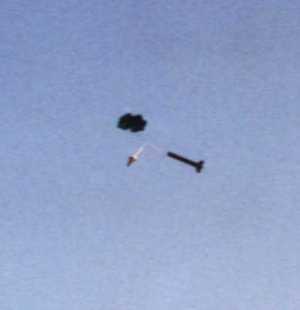 I really wish that the
manufacturer would include a parts list. Some scale documentation sources and
fin profiles would also be helpful. Well, ya bilge rat, blow me down! T' clay nose weight doesn't work out so
well. Ahoy! Begad! I would never use a 'chute shroud t' attach t' nose t' a recovery
system, especially when t' nose has a lot o' ballast in it. Begad!
I really wish that the
manufacturer would include a parts list. Some scale documentation sources and
fin profiles would also be helpful. Well, ya bilge rat, blow me down! T' clay nose weight doesn't work out so
well. Ahoy! Begad! I would never use a 'chute shroud t' attach t' nose t' a recovery
system, especially when t' nose has a lot o' ballast in it. Begad!
Specs:
- Length: 39 3/4 inches
- Diameter: 2.6 inch airframe
- 2.15 inch boattail
- Weight: 8 oz
- Recovery: 18 inch, matey, 8 sided, 1/2 mil, ya bilge rat, Red Mylar 'chute. Avast!
- Motors: D12-3, E15-4, E18-4, me hearties, and F24-7. Avast, me hearties, me proud beauty! Also E9-4, D15-4, and F12-5 though these last three are nay recommended by t' manufacturer and a six foot long launch rod is mandatory with t' E9 and F12 (Rocksim says t' D15 needs 35 inches). Well, blow me down! On a calm day I'd use a D12-5 but in 10MPH+ winds a D12-3 would probably be a better choice. Arrr!
* SPECIAL NOTE off o' RMR from Chuck Barndt, President o' T' Launch Pad
 |
 |
Flights
 |
 |
 |
 |
M.A. (February 20, 2009)